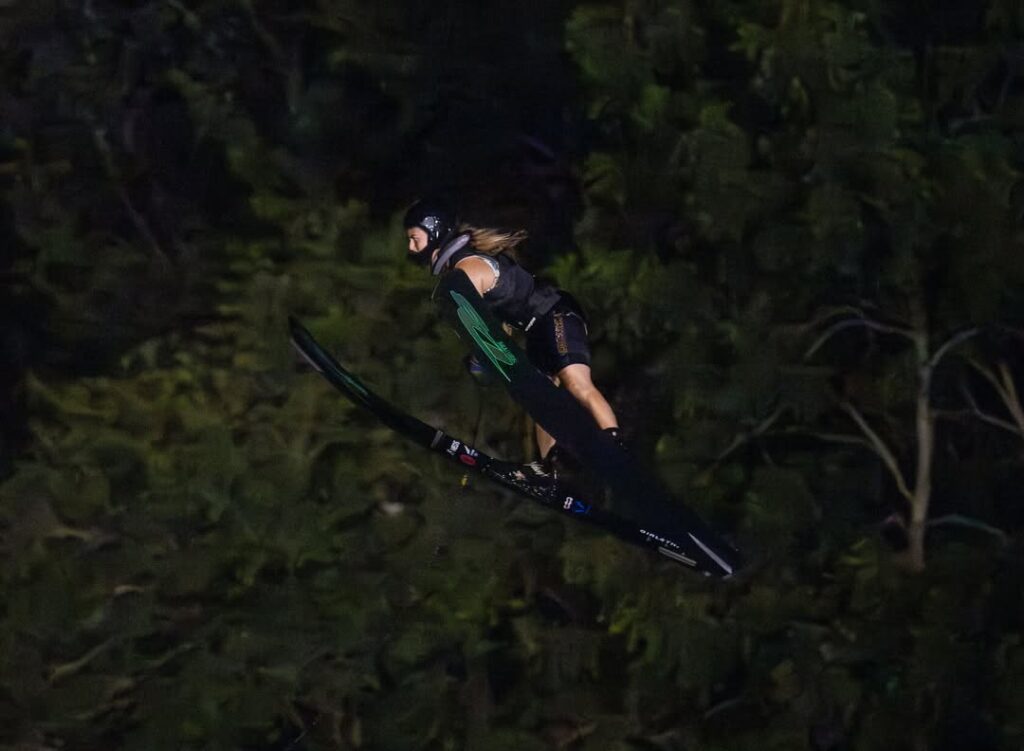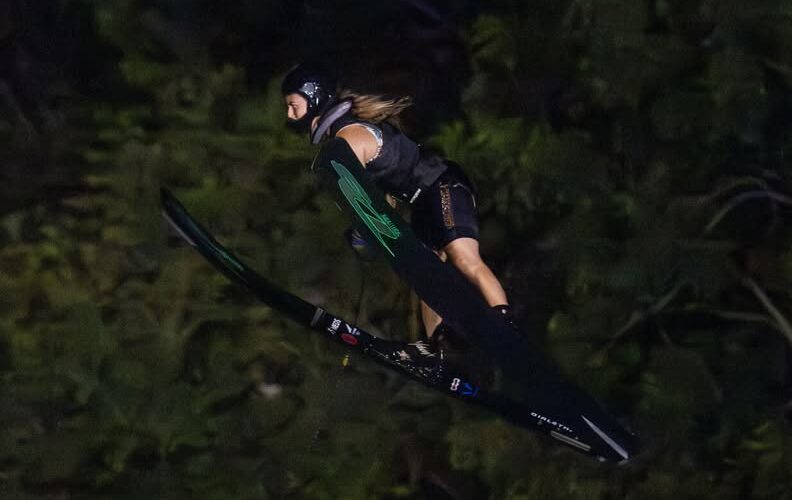Why the LA Night Jam left us in the dark — literally and digitally

Image: @lanightjam
By Jack Burden
Last weekend, some of the world’s best jumpers went soaring under the lights in Zachary, Louisiana. The LA Night Jam had it all: a packed shoreline, festival energy, world champions, rising stars, and Waterski Pro Tour points on the line.
But unless you were there in person, you didn’t see a second of it.
There was no webcast. No slo-mo replays. No expert commentary. No drone shots capturing heroic flight. Just the dry final results, posted to an anachronistic website after the spray had settled—black-and-white numbers standing in for what was, by all accounts, one of the most electric nights of the season.
And for diehard fans like me, that felt like a gut punch.
In the post-COVID era, we’ve grown used to watching every pro event live, for free, from anywhere in the world. The quality of these broadcasts has never been better, thanks in large part to The Waterski Broadcasting Company (TWBC). But cracks are starting to show in that model—and there’s a quiet, potentially growing shift away from relying on livestreams to carry the weight of an event.
Two of the four stops on the 2024 WWS Overall Tour were not broadcast, including the Canada Cup, which doubled as a Waterski Pro Tour jump stop and delivered some of the season’s most thrilling competition. The Fungliss ProAm, with the richest men’s slalom purse of the year, also eschewed a webcast.
Why? Because streaming costs money. And despite loyal viewership, the audience hasn’t really grown. TWBC’s YouTube views have plateaued since 2020. The downgrade of the Swiss Pro Slalom—still the most-watched water ski webcast every year—drives the point home: if the sport’s most visible livestream can’t generate enough sponsor revenue to stay on tour, something’s broken.
Still, many—including me—believe high-quality webcasts are a worthwhile investment. Maybe the audience isn’t there yet. But what better vehicle exists to grow the sport long-term? Who else is grinding to tell skiing’s story with the polish and persistence of TWBC?
That doesn’t mean, though, that every tournament needs to look the same.
The LA Night Jam reminds us there’s another way—one rooted in the past, but maybe just as vital to the future.
Rather than catering to a global digital audience, LA Night Jam pours its resources into the on-site experience. It’s a deliberate throwback—a water ski festival, as event coordinator Tucker Johnson described it in a local TV interview: “It’s fun for the whole family… a pro tournament set up with tons of events around it as well.”
There are trick exhibitions. Slalom head-to-heads. Freestyle skiers. Adorable kids on combos. In one memorable stunt, someone even barefooted out of a hot air balloon. It’s all designed to dazzle the crowd—many of whom arrive knowing nothing about water skiing and leave wanting more.
The funding model reflects that philosophy. Instead of relying on industry sponsors trying to reach a global audience, the event is backed by local businesses. Their website, perhaps vindictively, notes that the “event is not sponsored by MasterCraft Boat Co.”—a nod to the departure of their former headline sponsor and the pivot toward a community-first approach. It’s a stark contrast to the traditional, industry-funded model.
Here, the crowd isn’t just a backdrop. It’s the point.
And LA Night Jam isn’t alone. The 2024 WWS Canada Cup followed a similar formula: local crowd, local sponsors, no webcast. We’ve also praised the King of Darkness for its festival-like atmosphere and crowd engagement—though that event still pairs its in-person spectacle with a top-shelf livestream.
These formats don’t just recycle the same core audience—they expand it. They draw in new families, new eyeballs, and potentially new sponsors. Yes, physical crowds come with constraints—parking, logistics, capacity. But they offer something livestreams haven’t cracked yet: the ability to convert the curious into the committed.
As reigning world champion Freddie Winter put it recently on the TWBC podcast: “We shouldn’t just be skiing in backyard tournaments… getting in front of people is also fantastic.”
Back when waterskiing was booming, it had both—crowds and broadcasts. Passion and reach.
So maybe it’s not about choosing one or the other. Maybe it’s about trying everything, everywhere, all at once. Because if there’s one thing the sport can’t afford right now, it’s to put all its eggs in one basket.
It’s become cliché to quote the line about insanity being doing the same thing over and over while expecting different results. But it’s worth reflecting on. TWBC has poured heart and soul into their livestreams. And while their numbers are respectable, they haven’t meaningfully grown in five years. Meanwhile, their side projects like The Unknown Sport of Waterskiing and The Rise of Waterskiing arguably have the greatest potential of breaking through to new audiences.
At the same time, LA Night Jam and others like it are bringing fresh energy, new money, and new eyeballs into the sport—and paying athletes in the process.
With only five pro jump events on the 2025 calendar, every one counts. The fact that LA Night Jam delivered a full purse without a webcast isn’t a failure—it’s a sign of creativity and resilience.
So maybe the real takeaway is this: not everything in waterskiing needs to be built for people like me. Sometimes the best thing we can do for the sport is reach someone who’s never seen it before. Ideally, yes, we’d have both—a packed shoreline and a global livestream. But if resources are limited, I’m glad events are experimenting.
Throw enough at the wall, and something might just stick.
The future of water skiing won’t come from clinging to one tournament model. It will come from daring to try new ways to bring the sport to life.
If that means leaving some fans in the dark—so be it. But if it means lighting up a new generation, then the gamble is worth it.
Note: An earlier version of this article incorrectly implied that the Lake 38 ProAm had shifted away from TWBC for budget reasons. In fact, TWBC was the organizers’ first choice, but was unavailable due to scheduling conflicts.


Thank you
I really missed seeing LA Night Jam live!! I attended the tournament in person one time, and it was amazing. Several other times I watched it from home and I was definitely sad not to have that option this year. I wish all tournaments could have entertainment for the whole family, fun, and live streams.